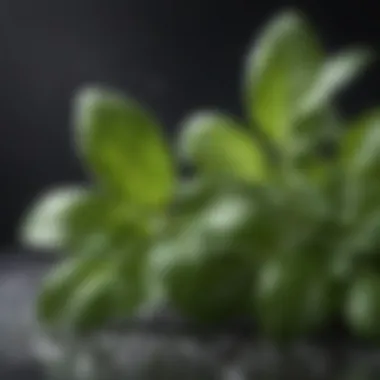Discover the Most Fragrant Plants for Your Space


Intro
In the pursuit of creating a harmonious environment, the incorporation of fragrant plants cannot be overstated. The right plant can not only enhance one’s living space but also evoke feelings of tranquility and joy. The world of aromatic flora offers a plethora of choices, with each plant bringing its own unique scent and characteristics to the table. Learning about these plants enables a deeper understanding of their cultivation needs and potential benefits.
Aromatic plants have been valued throughout history, not merely for their beauty, but also for their practical applications in cooking and healing. Their scents can uplift mood, create ambiance, and provide culinary bliss. This guide aims to explore some of the most delightful smelling plants, shedding light on their uses, cultivation tips, and the enriching experiences they offer.
By engaging with this guide, readers will discover how to fill their homes and gardens with captivating aromas. From popular culinary herbs to vibrant flowering plants, each has a role to play in enhancing one’s sensory experience. The journey through these fragrant plants is not just about aesthetics; it’s about the deeper connections we form with our surroundings. Let's delve into the fragrant world of plants, enriching both our spaces and our lives.
Intro to Aromatic Flora
Aromatic flora play a vital role in our environment, enriching both our sensory experiences and personal spaces. The scents emitted by certain plants can significantly influence mood, enhance the atmosphere, and even tempt our taste buds. This article aims to explore the characteristics, cultivation needs, and benefits of such fragrant plants. In doing so, it seeks to enlighten readers about the effects aromatic flora have on living spaces and overall well-being.
Aromas from plants can evoke memories, create ambiance, and provide comfort. This connection to scent is a driving force that encourages many to incorporate a variety of fragrant flora into their gardens and homes. Understanding their importance allows gardeners and plant enthusiasts to select species that not only please the nose but also serve practical functions such as pest deterrence and air purification.
Understanding Plant Aromas
The aroma of a plant arises from volatile organic compounds released into the air. These compounds vary widely among different species and can change with environmental factors, such as sunlight and water availability. Each scent has a unique composition, often consisting of a blend of terpenes, phenolics, and alcohols. These natural chemicals can also play roles in a plant's survival, attracting pollinators or deterring herbivores.
Studying plant aromas involves understanding how these scents are perceived. Humans have a complex olfactory system; our ability to identify and respond to different fragrances is deeply linked with memory and emotion. This is particularly relevant for culinary herbs, where the distinct scents correlate with flavor profiles.
Importance of Smell in Plant Selection
Selecting plants based on their aromas can enhance gardens and indoor spaces significantly. Here are a few considerations when choosing aromatic plants:
- Personal Preference: Individual tastes in scent vary. Some may favor sweet fragrances from plants like jasmine, while others might prefer the sharpness of rosemary.
- Functional Benefits: Certain aromatic plants, such as lavender and peppermint, also offer medicinal properties. They can uplift mood, relieve stress, or even provide health benefits when used in teas and oils.
- Environmental Factors: The plant's growing conditions—such as soil type, sunlight, and humidity—can affect aroma strength and quality. Ensuring that these factors align with the chosen aromatic plant's needs is crucial for optimal scent production.
Scent Selection is Key: "Choosing the right aromatic plant enhances not only the olfactory experience but also adds sensory richness to the environment."
In summary, understanding and selecting aromatic plants is essential for anyone looking to deepen their connection to their surroundings. The right scent can transform spaces, contribute to well-being, and provide immense enjoyment.
Indoor Best Smelling Plants
Indoor plants can transform a living space, not only visually but also through their scents. The right selection of aromatic plants can enhance comfort, amplify mood, and even improve overall well-being. The appeal of indoor flora is the accessibility; they can thrive in smaller spaces, such as apartments and homes. Moreover, their fragrances offer therapeutic effects, often making the atmosphere more relaxing and inviting. The indoor environment becomes a refuge when enhanced with the right aromas, creating a space that promotes mental health and serenity.
Herbs that Lend Fragrance
Mint
Mint is well-regarded for its refreshing and invigorating scent. This herb thrives indoors, requiring minimal care. The aromatic compounds released from its leaves can liven up a dull room. Mint is also known for its culinary uses, lending flavor to various dishes. During growth, its unique feature is the ability to spread quickly, leading to an abundant supply of fragrant leaves. However, this rapid growth may become a disadvantage for those with limited space, as it requires regular pruning to control its spread.
Basil
Basil offers a sweet and slightly peppery aroma that is often associated with Mediterranean cooking. Its fragrance not only enhances meals but contributes positively to indoor air quality. Basil plants enjoy sunny spots and can be harvested for their leaves. A unique feature of basil is its versatility, can be used fresh or dried in culinary applications. One potential drawback is its sensitivity to colder temperatures, making it necessary to protect it from drafts during winter months.
Rosemary


Rosemary is an evergreen herb with a distinct pine-like scent. Its needle-like leaves release a strong aroma, which is uplifting and refreshing. This plant is favored not only for its culinary uses but also for its potential cognitive benefits, as it may assist in improving memory. Rosemary prefers well-drained soil and bright light, making it somewhat easy to grow indoors. Nonetheless, one must be cautious of overwatering, as it can lead to root rot.
Ornamental Indoor Plants
Jasmine
Jasmine is beloved for its intoxicating fragrance that can fill a room. This plant exudes a sweet and soothing aroma, making it an excellent choice for bedrooms or relaxation spaces. Jasmine thrives in warm conditions with indirect sunlight, making it suitable for home environments. Its unique night-blooming characteristic offers the advantage of releasing its scent when people are likely to relax. However, it requires careful attention to humidity and watering to maintain optimal health.
Lavender
Lavender is another popular indoor choice, known for its calming properties. The scent of lavender is often linked to relaxation and stress relief. This herb can bloom brightly indoors and requires plenty of light to flourish. The unique feature of lavender is its versatility—it can be used in aromatherapy, cooking, or as a decorative element. A drawback is that lavender may not thrive in overly humid environments since it prefers dry conditions.
Gardenia
Gardenia plants exhibits a rich, sweet fragrance that appeals to many gardeners. The creamy white flowers bloom during warmer months, filling the air with their scent. Gardenias prefer acidic soil and can require consistent moisture, making them slightly challenging to maintain indoors. However, their unique appearance and delightful fragrance often outweigh these challenges, making them desirable for many indoor spaces. It's vital to watch out for pests, especially aphids, as they can affect the plant's growth.
Outdoor Best Smelling Plants
Outdoor aromatic plants contribute significantly to any garden design. Not only do they add beauty and texture, but their smells can create inviting spaces outdoors. The selection of these plants can enhance experiences such as gatherings and relaxation in the garden. Additionally, outdoor aromatic plants often attract various pollinators, playing a vital role in the ecosystem. When choosing these plants, consider factors such as climate, space, and the scent intensity desired.
Fragrant Flowering Plants
Roses
Roses are a classic example of fragrant flowering plants. Their rich, diverse scents range from sweet to spicy, making them a popular choice for gardens. One key characteristic of roses is their wide variety of colors and shapes, allowing for diverse landscape designs. These flowers are often admired for their velvety petals and strong fragrance. However, maintaining rose bushes can require a commitment as they may attract pests and demand specific care strategies, such as pruning. Overall, roses add beauty and an elegant scent to any garden.
Peonies
Peonies are known for their lush blooms and sweet fragrance. These plants can serve as focal points in a garden, often blooming in late spring to early summer. The key characteristic of peonies is their ability to produce large, densely packed flowers. This quality makes them visually striking. However, peonies can be delicate and may require some attention to thrive. Proper planting depth and care can lead to a rewarding display of scent and beauty.
Sweet Peas
Sweet peas are not only beautiful but also carry a delightful fragrance. Their climbing nature makes them excellent for trellises or fences, where they can add vertical interest. A significant aspect of sweet peas is their subtle, sweet scent, which can evoke memories of spring for many. These plants bloom in a variety of colors, enhancing visual appeal. On the downside, sweet peas require specific growing conditions, such as full sun and well-drained soil, to flourish successfully.
Aromatic Shrubs and Trees
Lemon Verbena
Lemon verbena is an aromatic shrub known for its refreshing lemon scent. It has long, slender leaves that release a strong fragrance when touched. This specific quality makes it ideal for culinary uses, such as flavoring teas or desserts. Lemon verbena is easy to grow, thriving in well-drained soil and plenty of sunlight. However, it is sensitive to frost, necessitating protection in colder climates. Overall, this shrub is a beneficial addition to any aromatic garden.
Scented Geraniums
Scented geraniums are unique for their variety of fragrances, ranging from lemon to rose. These shrubs can easily fit into smaller garden spaces, making them versatile. The key characteristic of scented geraniums is their aromatic leaves, which provide a delightful scent when brushed against. They offer a lower maintenance option for those seeking aromatic plants. One downside is that their blooms may not be as pronounced, which can detract from visual appeal for some gardeners.
Citrus Trees
Citrus trees, such as orange and lemon, provide not just fruit but also fragrance. Their blossoms emit a sweet, heady scent that fills the air, making them a top choice for outdoor spaces. Citrus trees require ample sunlight and well-draining soil, which makes them suitable for patios and gardens. However, these trees may need extra care in colder regions due to temperature sensitivity. Despite this need, their beautiful flowers and fruits offer a rewarding aromatherapeutic experience.


Culinary Applications of Aromatic Plants
Aromatic plants serve a significant role in culinary practices. They have the power to elevate dishes through their distinct and pleasing scents and flavors. Incorporating these plants into cooking not only enhances taste but also provides sensory experiences that can make dining more enjoyable. This section will focus on practical applications, highlighting how aromatic plants can be integrated into everyday cooking and beverages.
Herbs in Cooking
Enhancing Flavor
Herbs are essential in many culinary traditions. They enhance flavor in a variety of dishes, from simple salads to complex meals. Using aromatic herbs like basil or mint can transform a dish, making it more appealing. Their ability to provide freshness and depth makes them a valuable tool for chefs and home cooks alike.
One key characteristic of enhancing flavor through herbs is their concentrated oils. These natural compounds are what produce intense scents. Moreover, their unique properties allow them to balance and complement other flavors in a dish.
In this article, discussing enhancing flavor through herbs is important because it highlights the relationship between sensory experience and taste. Many people may not realize how crucial herbs can be in creating a memorable meal.
Traditional Dishes
Traditional dishes often rely heavily on aromatic herbs for authenticity. Regional recipes have been passed down through generations. These dishes reflect the flavors and aromas of the environment from which they originate. Whether it is using thyme in a French stew or cilantro in Mexican salsa, these traditional uses showcase the importance of aromatic plants in culinary heritage.
One distinct feature of traditional dishes is their cultural significance. They are not just meals; they tell stories about the people and places they come from. This aspect adds depth to the understanding of culinary applications of aromatic plants. Discussing this subject here enriches the reader's appreciation for food.
Infusing Fragrance into Beverages
Beverages provide another exciting avenue for using aromatic plants. They can add layers of complexity and enjoyment to drinks, allowing for creative combinations that delight the palate. Infusing fragrances into beverages offers refreshing options that enhance social experiences.
Herbal Teas
Herbal teas represent one of the most common uses of aromatic plants. They are often made by steeping various herbs like chamomile or peppermint in hot water. The resulting infusions not only have health benefits but also appeal to the senses through their aromas. A key characteristic of herbal teas is their versatility. They can be served hot or cold, making them adaptable for different occasions. In this article, discussing herbal teas emphasizes their significance in promoting relaxation and well-being through aromatic properties.
Garnishes for Cocktails
Cocktails present another creative application for aromatic plants. Fresh herbs such as mint or basil may be used as garnishes to enhance visual appeal and flavor. Adding a sprig of rosemary to a gin concoction can elevate the drink’s profile. The key here is the interaction between scent and taste; aromatic garnishes can influence a drinker's overall experience. This section helps readers understand the potential of combining herbs in mixology. It highlights a modern trend while connecting to culinary traditions.
Aromatic plants are more than just ingredients. They are essential members of culinary practices, promoting flavor and enhancing sensory experiences.
Aromatic plants provide significant benefits in both food and beverages. Their roles in enhancing flavor and contributing to traditional dishes are invaluable. Likewise, their usability in drinks makes them versatile assets in culinary applications. Readers benefit by learning how to effectively incorporate these plants into their meals and beverages.
Mental Well-Being and Aromatherapy
The exploration of aromatic plants extends beyond mere scent; it delves into aspects of mental well-being and the therapeutic uses of aromas. Aromatherapy is recognized for its potential to enhance emotional states and improve overall mental health. Engaging with fragrances from aromatic plants can transform spaces and influence our mood positively. This section outlines the intricate relationship between scent and mental well-being, supported by scientific findings.
The Science of Scent
Psychological Effects
The psychological aspect of scent can deeply influence emotions and behaviors. Research shows that specific fragrances can evoke memories or feelings, creating a sense of nostalgia or comfort. For instance, lavender is often associated with relaxation, making it a popular choice in aromatherapy.
A key characteristic of these psychological effects is their ability to facilitate emotional regulation. This aspect is beneficial in managing stress or anxiety levels, promoting a calmer state of mind. However, individual responses to scents can vary greatly. Some people may find certain fragrances overpowering or unpleasant, highlighting a disadvantage to consider when choosing scents for therapeutic purposes.
Cognitive Benefits
Cognitive benefits from aromatic plants are another critical area of interest. Studies suggest that certain scents can enhance focus and concentration. For example, rosemary is known for its ability to improve memory and cognitive performance. This characteristic is particularly beneficial for those looking to boost productivity while studying or working.
Moreover, cognitive enhancement through scent is popular among students and professionals. However, reliance on fragrances as cognitive aids may not be suitable for everyone. Some individuals may experience distractions instead of improvements, necessitating careful selection of scents for specific tasks.


Integrating Aromatic Plants into Daily Life
Creating Calming Spaces
Integrating aromatic plants into daily living spaces is essential for fostering a sense of tranquility. Creating calming spaces involves the thoughtful placement of plants known for their soothing effects. For instance, placing a few potted lavender plants in a bedroom may help induce sleep and relaxation, which is crucial in today’s fast-paced world.
This approach is beneficial for promoting mental well-being and encouraging mindfulness. However, it is vital to create balance; overly complex scents may result in feelings of confusion or irritation.
Aromatherapy Techniques
Aromatherapy techniques play a central role in how we incorporate scents into our daily routines. Techniques such as diffusing essential oils or using scented candles can create a welcoming atmosphere. These methods help in crafting specific moods tailored to various activities, whether relaxing, studying, or socializing.
The unique feature of aromatherapy techniques is their versatility. They can be easily integrated into any aspect of life, offering advantages such as ease of use and accessibility. Nevertheless, it is important to be cautious about the quality of products selected, as poor quality oils might not offer the desired benefits.
"Fragrance is the language of the soul, speaking to emotions and memories that words cannot convey."
This connection between scent and mental well-being highlights the importance of incorporating aromatic plants in our everyday lives. Understanding how to effectively blend these elements can lead to enriched experiences and improved quality of life.
Practical Tips for Cultivating Aromatic Plants
Cultivating aromatic plants can bring richness to gardens and homes. Understanding how to care for these plants not only enhances their fragrant nature but also increases their overall health and longevity. Knowledge of soil, water, light, and temperature preferences plays a crucial parts in successful cultivation. Moreover, aromatic plants can serve personal benefits, from improving mental well-being to enhancing flavor in culinary endeavors. Proper care translates to abundant growth and beautiful scent production.
Soil and Water Requirements
Soil is the foundation of any plant's life. For aromatic plants, the right soil promotes healthy root systems and enhances fragrance. Generally, aromatic plants prefer well-drained soil that retains some moisture without being waterlogged. A mix of potting soil and compost can provide the nutrients these plants need.
Watering practices are equally important. It’s essential to strike a balance. Too little water can lead to stress, while overwatering can cause root rot. Here are some points to consider:
- Check soil moisture: Insert a finger into the soil. If the top inch feels dry, it is time to water.
- Use room-temperature water: Cold water can shock the plant.
- Watering schedule: Most aromatic plants benefit from deep watering once a week, adjusting for seasonal changes.
Light and Temperature Preferences
Light and temperature significantly influence plant growth and fragrance. Aromatic plants generally require a lot of sunlight. A bright location, like a south-facing windowsill, can help plants reach their full aromatic potential.
- Light requirements: Aim for at least six hours of direct sunlight per day for best results.
- Shading: Some plants, like mint or lemon balm, can tolerate partial shade but produce less aroma.
Temperature is another key element. Most aromatic plants enjoy a warm climate, ideally between 65°F and 75°F. Protecting them from cold drafts or sudden temperature changes can support their growth.
Remember: Healthier plants often mean more potent aromas. Adjusting light and temperature is vital to maximizing your aromatic flora's fragrant contributions.
Culmination
Aromatic plants are an essential part of our lives, intricately intertwined with our emotions and daily experiences. By incorporating these fragrant species into our homes and gardens, we not only enhance the environment but also nurture our well-being. The diverse range of scents from plants like lavender or rosemary can elevate mood and create a sense of calm. This article emphasized the significance of these plants, enlightening readers about their cultivation, culinary uses, and mental health benefits.
The Role of Scent in Our Lives
The scents produced by plants impact our lives in profound ways. These aromas can trigger memories, evoke emotions, and even influence our mental states. Studies confirm that pleasant scents can reduce stress, promote relaxation, and improve overall mental clarity. For instance, the smell of fresh basil may remind someone of a cherished meal shared with family, while the fragrance of jasmine may instill a sense of calm in chaotic environments.
Moreover, distinct olfactory experiences can enhance the ambiance, making spaces feel more welcoming. This transformation is crucial for both home and professional settings, enhancing the aesthetic appeal. Consider how a simple plant can turn an ordinary room into a serene sanctuary.
In practical terms, understanding the role of scent can lead to better choices in plant selection. By choosing aromatic plants, individuals can create tailored environments that nurture psychological well-being and enhance their lifestyle. Planting and maintaining fragrant flora is not merely about aesthetics; it is a deliberate act of curating spaces that foster comfort, joy, and health.
Ultimately, integrating aromatic plants into our daily lives extends beyond the physical scent. It represents an opportunity to reconnect with nature, thereby promoting a harmonious atmosphere conducive to both work and relaxation.







